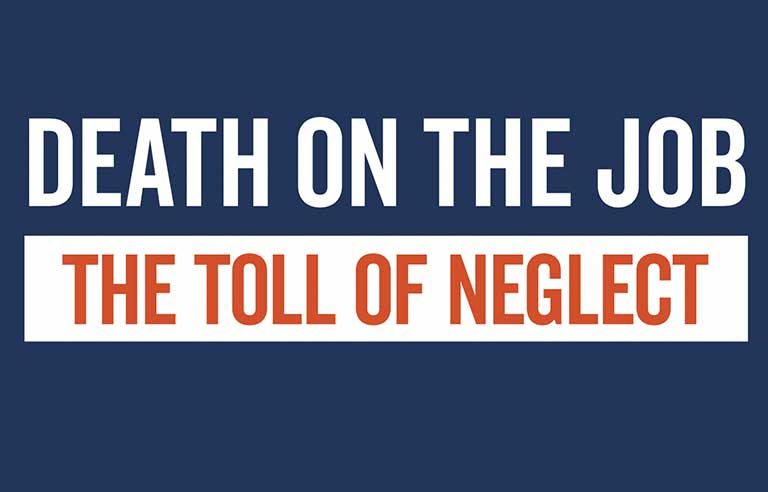Annual ‘Death on the Job’ report looks at the effects of COVID-19

Washington — The COVID-19 pandemic’s impact on workplace safety is among the issues explored in the AFL-CIO’s annual report on the state of safety and health protections for U.S. workers.
The 29th edition of Death on the Job: The Toll of Neglect – published Oct. 6 – features state and federal data on worker fatalities, injuries and illnesses, as well as worker protections. In particular, it examines some of the industries and workers most affected by the pandemic. For instance, among nursing home workers, more than 175,000 confirmed cases of COVID-19 were reported between May 24 and Sept. 6, in addition to nearly 121,000 suspected cases and 868 deaths.
The data shows that at least 163,000 health care workers had been infected, and 713 had died, as of Sept. 24, while the meatpacking, food processing and farming industries reported more than 58,000 infections and 238 deaths from April 22 to Sept. 16.
Overall, around 7.4 million people have tested positive for COVID-19 in the United States, and nearly 210,000 have died, Rebecca Reindel, AFL-CIO director of occupational safety and health, said Oct. 6 during a virtual news conference.
According to the report, susceptible work environments include indoor workplaces, those with poorly ventilated spaces or crowded working conditions, and where workers are in proximity to infected individuals.
“The pandemic has only emphasized what we already know,” Reindel said. “Workplaces are a major source of COVID outbreaks, and workplaces are inextricably linked with the safety of our families and our communities. So, preventing workplace exposures is key to stopping the spread of the virus.”
In 2018, 5,250 workers died on the job, according to the most recent data available from the Bureau of Labor Statistics. The report adds that an estimated 95,000 people died as a result of occupational diseases that same year, meaning, in all, 275 workers died each day. Additionally, employers reported approximately 3.5 million work-related injuries and illnesses – a number that actually might range from 7 million to 10.5 million because of underreporting.
| Sign up for Safety+Health's free monthly email newsletters and get the news that's important to you. |
Other noteworthy 2018 statistics:
- Workplace violence accounted for 828 deaths, including 453 homicides. Workplace violence was the second leading cause of occupational fatalities, behind transportation incidents (2,080 deaths).
- Deaths among Black workers increased to 615 from 530 in 2017. That total is a 46% increase from 10 years ago.
- Deaths among Latino workers increased to 961 from 903 in 2017. Deaths among Latino immigrant workers were the major contributor to this increase (641 compared with 568 in 2017).
- A third of the fatalities involved workers 55 and older, while those 65 or older had a fatality rate of 9.6 per 100,000 workers. The overall fatality rate was 3.5 per 100,000 workers.
- States with the highest fatality rates were Wyoming (11.5 per 100,000 workers), Alaska (9.9), North Dakota (9.6), West Virginia (7.9) and South Dakota (6.9).
- Federal OSHA had 746 inspectors – the lowest total since the early 1970s. The total number of workplace safety and health inspectors nationwide was 1,767, which included State Plan states. Those inspectors were responsible for 9.9 million workplaces under OSHA’s jurisdiction.
- The cost of workplace injuries and illnesses is estimated to be $250 billion to $330 billion annually.
“Nearly 50 years after the passage of the nation’s job safety laws, the toll of workplace injury, illness and death remains too high, and too many workers remain at serious risk,” the report states. “There is much more work to be done.”
Post a comment to this article
Safety+Health welcomes comments that promote respectful dialogue. Please stay on topic. Comments that contain personal attacks, profanity or abusive language – or those aggressively promoting products or services – will be removed. We reserve the right to determine which comments violate our comment policy. (Anonymous comments are welcome; merely skip the “name” field in the comment box. An email address is required but will not be included with your comment.)

